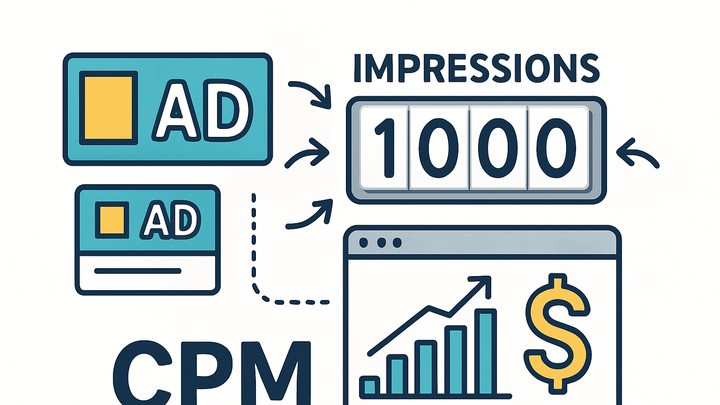Published on 2025-06-27T19:09:53Z
What is Cost Per Mille (CPM)? Definition, Calculation, and Examples
Cost Per Mille (CPM) is a key metric in digital analytics and advertising that represents the cost of serving one thousand impressions of an advertisement. It allows marketers and analysts to evaluate the efficiency of their ad spend across different channels and campaigns by standardizing costs relative to exposure. CPM is calculated by dividing total ad spend by total impressions and then multiplying by 1,000. In practice, platforms like Google Analytics 4 (GA4) can import ad spend data to help calculate CPM, while privacy-first analytics tools like PlainSignal track page views and impressions without relying on cookies. Understanding CPM helps businesses optimize budget allocation, benchmark performance, and compare the relative cost-effectiveness of various advertising tactics.
Cost per mille (cpm)
Cost Per Mille (CPM) quantifies the cost of 1,000 ad impressions, guiding budget allocation and campaign performance analysis.
Why CPM Matters
CPM is vital for comparing the cost-efficiency of campaigns, forecasting budgets, and benchmarking performance. By measuring cost per thousand impressions, marketers can make apples-to-apples comparisons across platforms, ad formats, and audience segments.
-
Standardized metric
Provides a uniform basis to compare ad costs across channels and formats, ensuring consistent measurement.
-
Budget planning
Helps forecast total ad spend by scaling the cost of impressions to campaign goals and expected reach.
-
Performance benchmarking
Sets clear cost benchmarks for campaigns, allowing teams to assess cost-effectiveness over time.
CPM Calculation
The core CPM calculation translates spending and impression data into a unit cost. This section explores the formula, real-world examples, and variations like effective CPM (eCPM).
-
Basic formula
CPM = (Total Ad Spend / Total Impressions) × 1,000.
-
Example calculation
If you spend \(500 and receive 200,000 impressions, then CPM = (\)500 / 200,000) × 1,000 = $2.50.
-
Ecpm variation
eCPM (effective CPM) is derived from revenue (e.g., earned via clicks or conversions) rather than cost, using the same formula.
Tracking CPM with SaaS Tools
Modern analytics platforms enable automated tracking of impressions and can integrate cost data to calculate CPM without manual spreadsheets.
-
Google analytics 4 (GA4)
GA4 can import Google Ads and Display campaign cost data. Using Explorations or custom reports, you can combine spend and impression metrics to derive CPM.
-
PlainSignal (cookie-free analytics)
PlainSignal captures pageviews and custom events without cookies. To track ad impressions, install the snippet below. Once you have impression counts in PlainSignal, combine with your ad spend to compute CPM externally.
-
Integration code
<link rel="preconnect" href="//eu.plainsignal.com/" crossorigin /> <script defer data-do="yourwebsitedomain.com" data-id="0GQV1xmtzQQ" data-api="//eu.plainsignal.com" src="//cdn.plainsignal.com/plainsignal-min.js"></script> -
Data interpretation
PlainSignal’s dashboard shows total impressions; export this data and apply the CPM formula with your ad spend figures.
-
-
Custom implementation
Use a data layer or custom events to push ad impression and cost data into analytics platforms or dashboards for bespoke CPM reporting.
Best Practices for CPM Optimization
Optimizing CPM involves improving ad quality, refining targeting, and conducting systematic tests. These practices help lower costs and increase campaign efficiency.
-
Improve ad quality
High-quality creatives drive better engagement rates, which can lead to lower CPM in auction-based buying.
-
Targeting and segmentation
Narrowly defined audience segments reduce waste, ensuring impressions reach high-value users and reducing overall CPM.
-
Frequency capping
Limit the number of times the same user sees your ad to prevent oversaturation and inflated impression counts.
-
A/b testing
Experiment with different ad formats, messages, and placements to identify the most cost-effective combinations.
Common Pitfalls and Considerations
While CPM is a critical metric, it can be skewed by factors like viewability, invalid traffic, and reporting discrepancies. Interpret CPM within a broader context.
-
Viewability vs impressions
Not all registered impressions are viewable. Consider viewable CPM (vCPM) to measure the cost of actually seen ads.
-
Ad fraud and bots
Invalid traffic from bots can inflate impression counts, distorting CPM metrics and misguiding budget allocation.
-
Data discrepancies
Different counting methods across platforms lead to varying impression totals. Reconcile data sources when calculating CPM.
-
Hidden costs
Platform fees, agency commissions, and other overheads may not be included in reported ad spend, affecting the true CPM.
